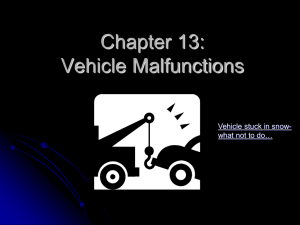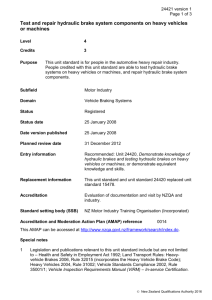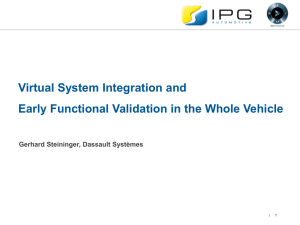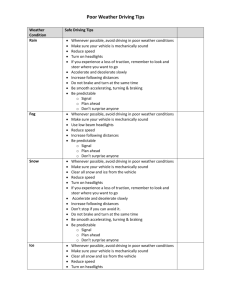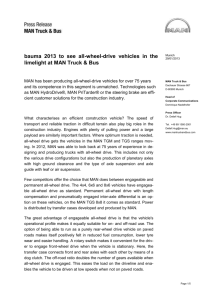I. Proposal
advertisement
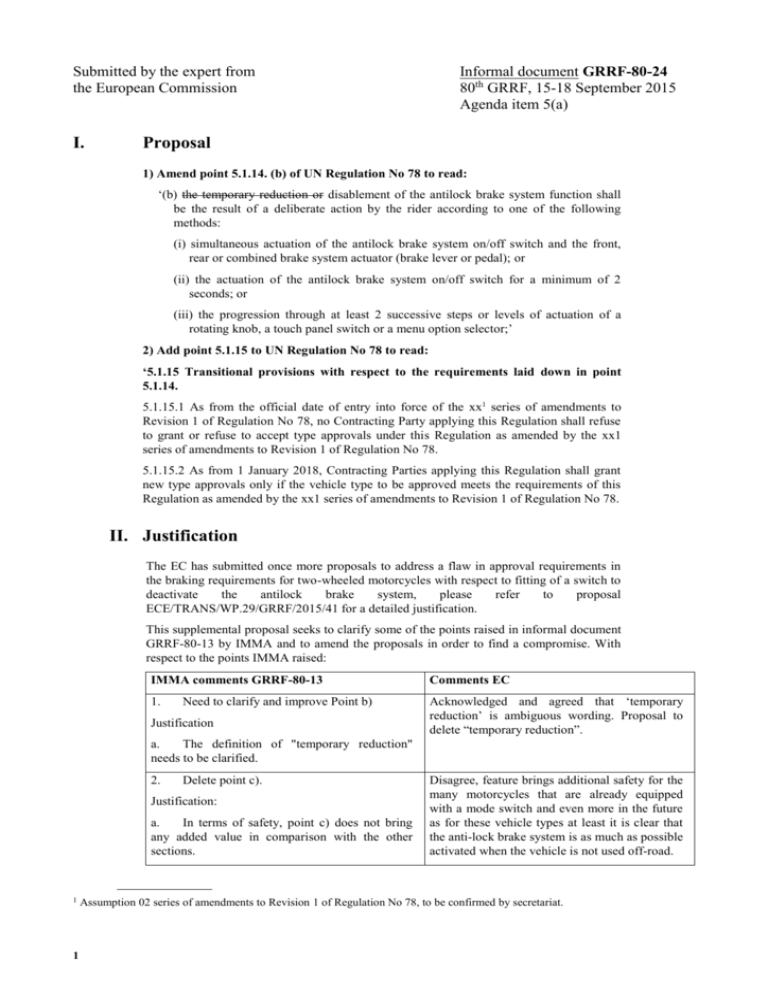
Submitted by the expert from the European Commission I. Informal document GRRF-80-24 80th GRRF, 15-18 September 2015 Agenda item 5(a) Proposal 1) Amend point 5.1.14. (b) of UN Regulation No 78 to read: ‘(b) the temporary reduction or disablement of the antilock brake system function shall be the result of a deliberate action by the rider according to one of the following methods: (i) simultaneous actuation of the antilock brake system on/off switch and the front, rear or combined brake system actuator (brake lever or pedal); or (ii) the actuation of the antilock brake system on/off switch for a minimum of 2 seconds; or (iii) the progression through at least 2 successive steps or levels of actuation of a rotating knob, a touch panel switch or a menu option selector;’ 2) Add point 5.1.15 to UN Regulation No 78 to read: ‘5.1.15 Transitional provisions with respect to the requirements laid down in point 5.1.14. 5.1.15.1 As from the official date of entry into force of the xx1 series of amendments to Revision 1 of Regulation No 78, no Contracting Party applying this Regulation shall refuse to grant or refuse to accept type approvals under this Regulation as amended by the xx1 series of amendments to Revision 1 of Regulation No 78. 5.1.15.2 As from 1 January 2018, Contracting Parties applying this Regulation shall grant new type approvals only if the vehicle type to be approved meets the requirements of this Regulation as amended by the xx1 series of amendments to Revision 1 of Regulation No 78. II. Justification The EC has submitted once more proposals to address a flaw in approval requirements in the braking requirements for two-wheeled motorcycles with respect to fitting of a switch to deactivate the antilock brake system, please refer to proposal ECE/TRANS/WP.29/GRRF/2015/41 for a detailed justification. This supplemental proposal seeks to clarify some of the points raised in informal document GRRF-80-13 by IMMA and to amend the proposals in order to find a compromise. With respect to the points IMMA raised: IMMA comments GRRF-80-13 Comments EC 1. Acknowledged and agreed that ‘temporary reduction’ is ambiguous wording. Proposal to delete “temporary reduction”. Need to clarify and improve Point b) Justification a. The definition of "temporary reduction" needs to be clarified. 2. Delete point c). Justification: a. In terms of safety, point c) does not bring any added value in comparison with the other sections. 1 1 Disagree, feature brings additional safety for the many motorcycles that are already equipped with a mode switch and even more in the future as for these vehicle types at least it is clear that the anti-lock brake system is as much as possible activated when the vehicle is not used off-road. Assumption 02 series of amendments to Revision 1 of Regulation No 78, to be confirmed by secretariat. b. There remains a lack of clarity regarding the wording: “off-road”, “all terrain mode” or ‘any other riding mode electronically preparing the vehicle for off-road use’ ‘Off-road’ is a clear expression, although not defined in legislation and means “unpaved roads”, “dirt roads” or terrain without asphalt, concrete or other conventional road surface materials. Again it should be stressed that vehicle classification based on its use is not acceptable if the vehicle manufacturers are not willing to provide robust and technically objective classification criteria. 3. This is the key point of the proposal. No compromise accepted. Delete point f). Justification: a. There is a practical problem to ensure appropriate ‘keep live’ conditions. How to avoid unintended overwriting or erasing by a new key sequence after an accident? b. There is also no guarantee that data will be available after a serious crash as, e.g., the ECU may be damaged. c. There is no other precedent so far in type approval legislation (EC/ECE) (e.g. no such requirement for ESC off). The UNECE Regulation No. 78 and UN GTR No. 3 are specifying vehicle braking performance requirements rather than accident research requirements. 4. Replace point (h) with: “(h) simple and instantaneous re-enablement of a functional stage which complies with anti-lock brake system approval requirements of the antilock brake system under all operation modes and driving conditions shall be warranted and shall be demonstrated to the satisfaction of the certification authority (e.g. simple press of a button).” The justification is only partly understood, in particular point “a” is not clear and well justified. However, under the condition that point f is accepted this compromise can be accepted. Justification a. More technology neutral wording. b. It is technically not feasible to warrant the possibility of the instantaneous reactivation under all driving conditions, especially not when the ABS function had been deactivated completely. c. The ABS system requires a certain driving condition of the vehicle in order to perform a system verification/calibration procedure before starting up the ABS function. 5. The proposed changes are significant. Transitional provisions will be needed given the necessary lead time for adaptation. Accepted, refer to the draft proposal on transitional provisions in this document.


